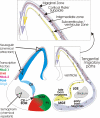Development of cortical GABAergic innervation
- PMID: 21808605
- PMCID: PMC3139172
- DOI: 10.3389/fncel.2011.00014
Development of cortical GABAergic innervation
Abstract
The mature neocortex contains many different classes of GABAergic inhibitory interneurons, distributed, with some degree of selectivity, through six layers, and through many different regions. Some of the events in the early lives of these neurones that may determine their ultimate destination, their maturation and their selective innervation of targets appropriate for each subtype, are discussed. Both time and place of birth influence the class of interneuron that an early post-mitotic interneuronal precursor will become, driven by the selective expression of different combinations of transcription factors in different regions of their birth places in the ganglionic eminence and ventricular zone. The long distance migration of these precursors along tangential routes in marginal, subventricular, and intermediate zones and their final radial movement, into the developing cortex, is regulated by chemical cues, both attractant and repellent. Once they arrive at their final destination, they must integrate into the developing circuitry. As they mature within the cortex, their axons grow and branch in highly specific patterns that may be partially determined by the genetic blueprint for each interneuronal class and partly by the environment in which they find themselves. Finally, as each interneuron class begins to form synapses with only certain postsynaptic targets, cell-cell recognition, most probably via protein-protein interactions across the synaptic cleft, facilitate the formation of appropriate synapses.
Keywords: GABA; cortex; development; ganglionic eminence; inhibition; interneuron; synapse; synaptogenesis.
Figures

References
-
- Andang M., Hjerling-Leffler J., Moliner A., Lundgren T. K., Castelo-Branco G., Nanou E., Pozas E., Bryja V., Halliez S., Nishimaru H., Wilbertz J., Arenas E., Koltzenburg M., Charnay P., El M. A., Ibanez C. F., Ernfors P. (2008). Histone H2AX-dependent GABA(A) receptor regulation of stem cell proliferation. Nature 451, 460–46410.1038/nature06488 - DOI - PubMed
-
- Anderson S. A., Qiu M., Bulfone A., Eisenstat D. D., Meneses J., Pedersen R., Rubenstein J. L. (1997b). Mutations of the homeobox genes Dlx-1 and Dlx-2 disrupt the striatal subventricular zone and differentiation of late born striatal neurons. Neuron 19, 27–3710.1016/S0896-6273(00)80345-1 - DOI - PubMed
Grants and funding
LinkOut - more resources
Full Text Sources
Research Materials

